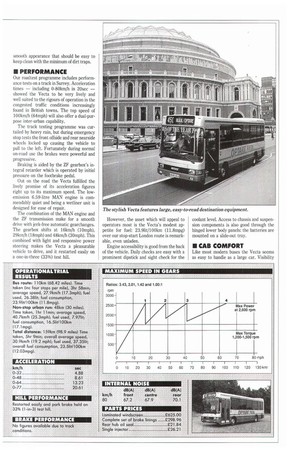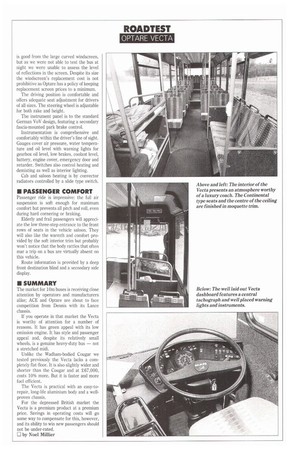• While much of Britain's beleaguered bus manufacturing industry has
Page 33

Page 34

Page 35

Page 36

If you've noticed an error in this article please click here to report it so we can fix it.
been talking gloom and despondency, Leeds-based Optare has confidently continued building and developing models to fill just about every niche available in the market.
Since the introduction of the City Pacer in 1985 it has produced each model in partnership with a single chassis manufacturer. In the case of the CityPacer it was Volkswagen; for the StarRider it was MercedesBenz; for the full-size Delta single-decker and the double-decker that will follow it soon Optare is working with its United Bus stablemate Daf Bus.
To move into the neglected 10m market it has worked with MAN to produce the Vecta on an exclusive version of the 10.180 HOCL air-suspended bus chassis. It has 45 seats with room for 16 standing.
The Vecta's most direct competitor in terms of price, size, specification and passenger capacity is the ACE Cougar (CM 7-13 March), which is available with Wadham Stringer Portsdown or Willowbrook Warrior bodywork.
Both vehicles are highly manoeuvrable and lively, and both offer the excellent passenger accessibility that the market increasingly demands.
Our test vehicle was the first Vecta to be built and had been through an intensive demonstration programme with operators nationwide before we took it over our arduous trans-London test route.
• BODYWORK
Like the Cougar, the Vecta has a 135kW (180hp) rear-mounted engine and features full air suspension. It seems equally capable of replacing aging Leyland Nationals, as well as representing the next step in the progression from van-derived minibuses to midis and super midis.
At 2.5m the Vecta is wider than either the Cougar or the lighter Dennis Dart; it is 500mm shorter than the 10.5m Cougar.
The special 4.9m-wheelbase MAN 10.180 HOCL chassis comes with fully automatic 2F 11P500 transmission. Offered by a number of European bodybuilders as a basis for luxury coach bodywork, it is normally built with a 4.2m wheelbase with manual transmission.
With relatively small 19.53(6.75 wheels Optare has achieved a first level step height of 295mm with two intermediate steps of 195mm to give access to the first five rows of forward facing seats.
Another step in the middle of the saloon takes you to the next four rows, with the rest of the seats mounted higher still.
Carpet-type trim on the ceiling and side walls combines with red DIPTAC-approved hand rails, continental individual seats and dark, non-slip floor covering gives the Vecta interior a stylish appearance that should prove reasonably easy to keep clean.
All step edges have two-colour nosings to make life easier for partially sighted passengers. There is a large luggage pen immediately behind the driver's compartment on the offside of the saloon and colour coordinated laminate ceiling and side panels are available as an option.
The MAN chassis frame is constructed using screw connectors. It features a flat frame to just forward of the rear axles; the radiator is mounted at the nearside alongside the longitudinally mounted vertical engine.
For the Vecta, Optare uses the same Alusuisse aluminium alloy structure system as its larger Daf-based Delta bus. The two designs share the same window sizes and rear panels. The body system is designed for ease of repair with all lower panels hinged for easy accessibility. Front and rear bumpers are also in sections to allow quick and economical repairs to be made to the most vulnerable areas of the vehicle.
One-piece extrusions running from the front to the rear of the body sides give a smooth appearance that should be easy to keep clean with the minimum of dirt traps.
• PERFORMANCE
Our roadtest programme includes performance tests on a track in Surrey. Acceleration times including 0-80km/h in 20sec showed the Vecta to be very lively and well suited to the rigours of operation in the congested traffic conditions increasingly found in British towns. The top speed of 100km/h (64mph) will also offer a dual-purpose inter-urban capability.
The track testing programme was curtailed by heavy rain, but during emergency stop tests the front offside and rear nearside wheels locked up causing the vehicle to pull to the left. Fortunately during normal on-road use the brakes were powerful and progressive.
Braking is aided by the ZF gearbox's integral retarder which is operated by initial pressure on the footbrake pedal.
Out on the road the Vecta fulfilled the lively promise of its acceleration figures right up to its maximum speed. The lowemission 6.59-litre MAN engine is commendably quiet and being a wetliner unit is designed for ease of repair.
The combination of the MAN engine and the ZF transmission make for a smooth drive with jerk-free automatic gearchanges. The gearbox shifts at 161cm/h (10mph), 29km/h (18mph) and 48km/h (30mph). This combined with light and responsive power steering makes the Vecta a pleasurable vehicle to drive, and it restarted easily on a one-in-three (33%) test hill. However, the asset which will appeal to operators most is the Vecta's modest appetite for fuel: 23.91it/1001trn (11.8mpg) over our stop-start London route is remarkable, even unladen.
Engine accessibility is good from the back of the vehicle. Daily checks are easy with a prominent dipstick and sight check for the coolant level. Access to chassis and suspension components is also good through the hinged lower body panels: the batteries are mounted on a slide-out tray.
• CAB COMFORT
Like most modern buses the Vecta seems as easy to handle as a large car. Visibility is good from the large curved windscreen, but as we were not able to test the bus at night we were unable to assess the level of reflections in the screen. Despite its size the windscreen's replacement cost is not prohibitive as Optare has a policy of keeping replacement screen prices to a minimum.
The driving position is comfortable and offers adequate seat adjustment for drivers of all sizes. The steering wheel is adjustable for both rake and height.
The instrument panel is to the standard German VoV design, featuring a secondary fascia-mounted park brake control.
Instrumentation is comprehensive and comfortably within the driver's line of sight. Gauges cover air pressure, water temperature and oil level with warning lights for gearbox oil level, low brakes, coolant level, battery, engine cover, emergency door and retarder. Switches also control heating and demisting as well as interior lighting.
Cab and saloon heating is by convector radiators controlled by a slide type switch.
• PASSENGER COMFORT
Passenger ride is impressive: the full air suspension is soft enough for maximum comfort but prevents all pitch and roll, even during hard cornering or braking.
Elderly and frail passengers will appreciate the low three-step entrance to the front rows of seats in the vehicle saloon. They will also like the warmth and comfort provided by the soft interior trim but probably won't notice that the body rattles that often mar a trip on a bus are virtually absent on this vehicle.
Route information is provided by a deep front destination blind and a secondary side display.
• SUMMARY
The market for 10m buses is receiving close attention by operators and manufacturers alike; ACE and Optare are about to face competition from Dennis with its Lance chassis.
If you operate in that market the Vecta is worthy of attention for a number of reasons. It has green appeal with its low emission engine. It has style and passenger appeal and, despite its relatively small wheels, is a genuine heavy-duty bus — not a stretched midi.
Unlike the Wadham-bodied Cougar we tested previously the Vecta lacks a completely flat floor. It is also slightly wider and shorter than the Cougar and at £67,000, costs 10% more. But it is faster and more fuel efficient.
The Vecta is practical with an easy-torepair, long-life aluminium body and a wellproven chassis.
For the depressed British market the Vecta is a premium product at a premium price. Savings in operating costs will go some way to compensate for this, however, and its ability to win new passengers should not be under-rated.
0 by Noel Mailer
































































































